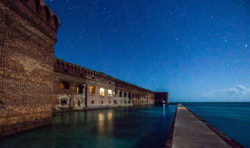The following article is part of a series of blog posts from the Holcombe family. Peter, Kathy, and their Keystone sixth grader, Abby, are sharing their adventures with Learning Liftoff as they journey on an 18-month tour of the country’s national parks. And, Abby is taking her high-quality education on the road with The Keystone School, a fully accredited, online private school.
As the approaching cold of winter relentlessly pushed us down the Eastern Seaboard, Dry Tortugas National Park in Florida began to call to us, like sirens to a sailor. And so we found ourselves at the ferry terminal in Key West, Florida, about to board the Yankee Freedom for the 90-mile voyage to Fort Jefferson.

Weather reports on the morning of our departure called for high winds and rain for the entire duration of our stay, but we forged ahead hopeful for a break in a very bleak forecast. We were buffeted with rain the entire three-hour trip to the island, and were beginning to question our decision to press on, but as we approached the 150-year-old fort, the sun appeared and the winds abated. As soon as we arrived, we set up camp and hit the beach, taking full advantage of the window of beautiful weather.
Before long, the wind drove us off of the beach and into our mask and fins for a snorkeling tour around the perimeter of the island. Flanking the harbor on either side lay the remains of two old piers. All that is left are the pilings—a grid of metal beams that once served as a safe haven for ships and now provides refuge for a wide variety of sea life ranging from sponges and coral to barracuda and colorful reef fish. Although there were strong currents that pushed and pulled us through the labyrinth of debris, it quickly became my favorite snorkeling playground.
That afternoon, as we waved goodbye to the ferry and its 250 occupants, the almost vacant island became our own with only a few park service employees and a handful of campers remaining. We took up positions on the dock intently focused on its resident school of snapper, and within hours caught enough fresh fish to feed our hungry party. As evening gave way to night, we shared stories of adventures past and admired the multitude of stars, both shooting and stationary, that blanketed the night sky.
The next day we befriended one of the rangers who lived on the island. The park became a true outdoor classroom for Abby as the ranger shared stories and an insider perspective of the island that kept us riveted for hours. He taught us how to harvest a coconut for the delicious water hiding deep within the thick husk, and told tales of the colorful inhabitants of Fort Jefferson from long ago. The fort served as a remote prison that once held Dr. Samuel Mudd, the physician who was convicted in the Abraham Lincoln assassination trial after he treated John Wilkes Booth’s broken leg. The lessons for Abby and all of us ranged from the natural history of the birds, plants, and sea life to the cultural history of the fort, the prison, the shipwrecks, and the early explorers. All of these hands-on lessons supplemented Abby’s online classroom education with Keystone and gave her invaluable context to her many subjects, including current events.
In fact, it was the events that are still taking place on the island that had the most impact for me. The ranger shared with us personal accounts of Cuban refugees who continue to seek asylum on one of the many islands located within the park.
His accounts were of vessels composed of bolted-together sheet metal with a single, homemade propeller, and powered by a sputtering and often failing motor, typically salvaged from a car built in the 1950s, assembled in secrecy, and arriving in the park under a veil of darkness. These marginally seaworthy vessels often transported 30 or more people more than a hundred miles before landing (or sinking) within the park boundaries.
In 2015, there were almost 600 landings in Dry Tortugas National Park and, when we arrived, it had been four days since the arrival of the last group of refugees. The ranger cautioned that based on the dramatic increase in the number of refugees targeting the park, we would likely witness a landing during our four-day stint on the island. We were instructed to notify him immediately upon their arrival as they would likely be nearly drowning and suffering from chemical burns and severe dehydration.
The responsibility of the Park Service is strictly humanitarian in nature: to provide essential food, water, clothing, and basic medical care. After that, the refugees are turned over to the U.S. Coast Guard where one of two things will happen: those that step foot on U.S. soil will be transported to Miami where they will be given work permits and financial aid for food and housing. After a year, they will automatically be granted permanent residency. Those who do not make it to dry land will be returned to Cuba, often facing retribution for their attempted escape. This is based on a law set by Kennedy known as the Cuban Adjustment Act in 1962 and revised to the “Wet Feet, Dry Feet” policy under Clinton in 1995. With the change in relations with Cuba, it is likely that there will be another revision to the Act in the very near future—thus the recent dramatic increase in the number of Cubans seeking asylum.
For the remainder of our four-day vacation, I couldn’t escape the irony that one family’s getaway to a secluded island paradise is the same destination as another family’s gateway to a completely new life full of endless possibilities. Both families travel 100 miles across the open sea. While we enjoyed the safety and comfort of the Yankee Freedom ferry boat and spent our days lounging on the beach, fishing, snorkeling, and enjoying the leisurely pace of island life, there is another family out there planning an escape of an entirely different nature—willing to risk their lives for the opportunity to live the same hectic lifestyle that we are so eager to escape.
One of my favorite aspects of travel is the continuous immersion in new environments and new cultures. Regardless of where we go or what we do, we are forever learning about the different circumstances of the people who live there. Because of our visit to Dry Tortugas National Park, we have gained a new perspective and a greater understanding of life outside of our own personal universe. That, among countless other experiences, is what keeps us pushing forward on this grand adventure of life on the road. Watch our video of this specific adventure online!



























































































































